
The evidence comes from a Mormon Baptismal endowment made by 'Mormon John' in 1872.
'Mormon John' was a grandson of 'Camlet John.' In this baptismal endowment, John listed that he was Grand-nephew to 'Joseph Gordon, Francis Gordon & Peter Gordon' - this tells us that 'Camlet John.' had at least THREE BROTHERS! This entry and other entries can be found on microfilm 1149520.
This same film raises Peter Gordon sometime in Balindory as father of 'Camlet John,' 'Camlet Joseph,' 'Camlet Francis' and 'Camlet Peter.'
Furthermore the film confirms a 'Leys mother' for 'Camlet John' - her name being 'Barbara Lay'
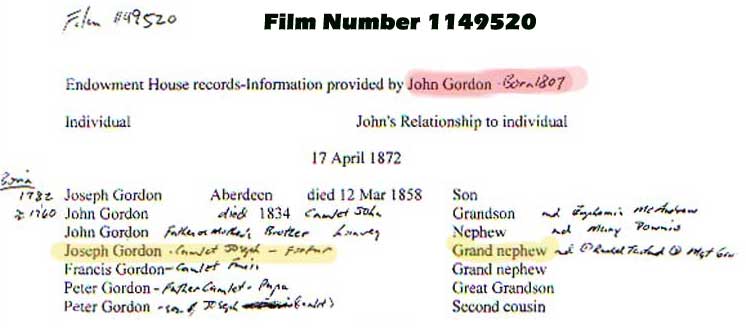
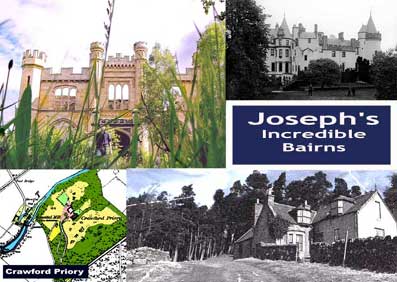
1) His first wife was Rachel Tastard whom he married in July 1788 (Crathie)
2) His Second wife was Margaret Stewart whom he married in May 1800 (Crathie)
To Rachel he had FOUR sons: John, Joseph, James & Peter.
Rachel must have died in childbirth or puerperally, certainly a short time after the birth of her last son Peter in 1798.
Two years later, with a young family of four boistrous loons, Joseph remarried. His wife, on this occasion, Margaret Stewart, was much his junior. With Margaret Stewart, Joseph brought forth a further eight bairns - though it appears likely some of his 'legion' were lost in infancy.
At some stage there was a flit fae Bovagli, for by 1829, Joseph and family (it seems) were residing at the foot of Glenmuick at Wardhead of Braichlie.
1841: Joseph Gordon, by now an old-man appeared (on the census) as a Lodger at Cambus o' May Inn. He was there with his wife Margaret. Aged 85 years - he was still described as a 'Stocking Merchant'
1841 census - Cambus O May
District 11 pages 6/7
James Ogg 67 Publican Yes
George Ogg 40 Cattle dealer Yes
John Ogg 25 Farmer Yes
Elizabeth Copland 25 F.S. Yes
Agnes Gordon 14 F.S. Yes
Archibald Archibald 15 Ag lab Yes
Joseph Gordon 85 stockng merchant Yes
Margaret Gordon 69 Yes
In June 1820, Jane, daughter of Joseph, brought forth little Peter Ogg an illegitimate bairn. The father was George Ogg, listed above on the census beneath his own father James Ogg 'the Publican'
June 30: George OGG Little Kanord and Jane GORDON in Bellamore had a son born in fornication - Peter
Now the story of the Oggs, the Innkeepers and Wardhead is for another day. Suffice to say for now that the Gordons of Girnoc were well-aquainted with them
This writer, for the record, believes deeply that 'Camlet Joseph' was a BROTHER of 'Camlet John.'
Like every Girnoc loon, certainty is never sure-of-foot and here with 'Camlet Joseph' the wobbling stagger was to Bovagli. For it was at Bovagli (and not Camlet) that all of Joseph's children were born.
So why give Joseph the title 'Camlet Joseph'? Well there are many reasons indeed, but perhaps the most striking is that John Gordon of Crovie made NO MENTION at all of Joseph in his eponymous 'Bovagli MS' (written in 1872). The reason for this omission, this writer (and others) have concluded, is that Joseph Gordon was not of the Bovagli family.
Opposing this was a distant call of a Joseph descendent in the name of Mrs Forbes of Milnathort, who the ever dilligent Dr Bulloch corresponded with in 1913:
"There seem to have been, in the middle of the eighteenth century, five tenants in Bovaglie, and a certain Joseph Gordon was one of them. I do not know his connection, if any, with the Donald Gordons in Bovaglie. His granddaughter, Mrs Forbes Laurel Bank, Milnathort, Kinross, suggested to me in 1913 that Joseph was a brother of Donald Gordon, Bovaglie (1771-1854). But I cannot prove the statement."
You can sense Dr Bulloch's scepticism, and indeed his continuators, Edward of Cairnfield and Donald Whyte of Kirkliston, both printed accounts of Joseph and his family, and both included him with Camlet rather than Bovagli.
It is likely Mrs Forbes was wrong. For a start the dates she offers do not tie: Joseph was born in the mid 1750's (as it seems were the 'other Camlet sibs') - to fit him in with Bovagli, given these dates seems most unlikely. The Bovagli' parents were James Gordon & Janet Smith/Gow, who did not (according to the Bovagli MS) have children until the 1760's. There is NO mention of a Joseph born 1755.
Do primary records help here? Well in a word, No. However corroboration for Camlet comes in a literal score of connections, which viewed together, serve to secure this writer's utter confidence in Joseph's Camlet origins.
1) For some reason, 'Camlet John' named his first son Joseph! Makes one think why does it not.
2) The memorial to the son of 'Camlet Joseph' is shoulder-to-shoulder in Glenmuick with the Camlet stone (Euphemia McAndrew)
3) Joseph was an Abergeldie name - the 10th Laird, Rachel Gordon, called her second son Joseph.
4) The family of 'Camlet Joseph' had remarkable pathways through life - the narrative of which will follow here. Following close in the route of Joseph's family was the present writer's 'branch' of the family of 'Camlet John.' It is a fascinating journey, still unravelling, that potentially takes 'Camlet' back to Abergeldie. Yet as yet it is just that - a story.
Let us then explore 'Camlet Joseph' and his remarkable family.
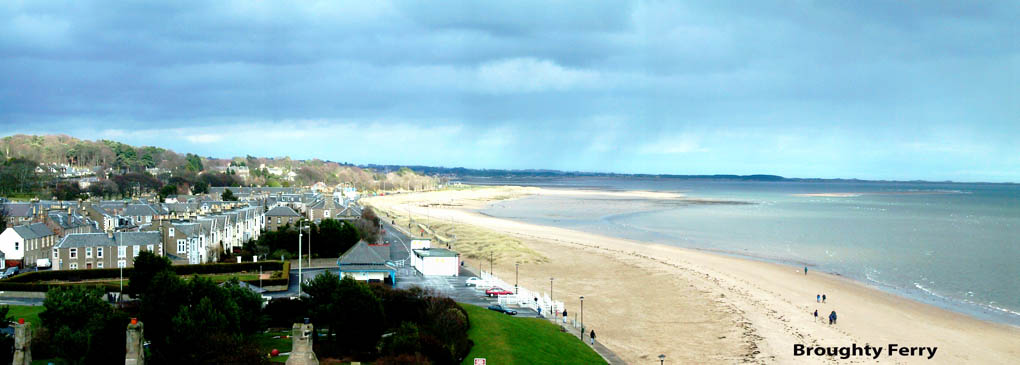
This may be coincidence - but if so, let us call it coincidence one.
It is possible also that the Gray family- who purchased a brewery in Broughty c1845 (Springbank) were related (but this is as yet utterly hypothetical.) The potential connection is with Elizabeth Gray, the second spouse of the above Peter Gordon 11th Laird. Now on the Grays, there is much more to follow. For now just note that the Gray Family were feudal superiors of Liff & Benzie (land to the west of Dundee, stretching a good way towards Perth.)
Based on the 1851 census, it appears that his Linen mill was in the village of Lochee (now subsumed into Dundee) - at that period of time it was part of Liff parish. The mill (the writer assumes it was this one) appears on the ordinance survey map of c1860.
1851 Census - Ryehill Park, Village of Lochee (now Dundee), Liff & Benzie
John Gordon, Head, Married, age 58yrs, Linen Manufacturer employing 26 men, born Crathie
Mary Gordon, Wife, age 57yrs, born Fettercairn, Kincardineshire
Eliza Gordon, Daughter, Unmarried, age 26yrs, born Forfar, Dundee
John Gordon, Son, age 21yrs, Bank Accountant, born Liff parish
Catherine Gordon, Daughter, Unmarried, age 18yrs, born Liff parish
Helen Gordon, Daughter, Unmarried, Scholar, age 14yrs, born Liff parish
John found wealth, but in completely unforseen circumstances he lost it. You see, he and several of his brothers invested heavily in the City of Glasgow Bank which crashed utterly in 1878. With no warning whatsoever, John and his brothers Joseph and Donald, were demanded with a bill of �30,000. Yes �30,000! Exactly how they managed, cannot be said (that needs further investigation) but all three managed to retain solvency thereafter and returned, it seems to prosperous family lives.
The Gray Family (on whom, the writer immediately expresses his limited knowledge upon) were well known feudal superiors: of Broughty Ferry (again, like the Hunters) & Benzie. The father of Elizabeth Gray (born c1695) was Lord John Gray, the 9th Laird. He was known in Aberdeenshire (his name appears in a 1670 extract) but subsequently received a charter of lands of Benvie from James, Earl of Panmure in 1713 and began to build the house of Gray at Nethertoun in 1714 - it took two years to build.
House of Gray is utterly beautiful - it was only just finished, when it 'celebrated' the marriage of Lord Gray's second youngest daughter Elizabeth. So one assumes a marriage of utter splendour for Peter Gordon 11th of Abergeldie. It must have warmed Abergeldie's heart, after the early loss of his first wife, Margaret Strachan.
Now here, details are scant. We know that Peter Gordon 11th Laird had 6 children and only one of these, was a boy - Charles (served heir to his father in 1737 at the age of 15yrs). Still further confusion arises as Peter Gordon the 11th Laird married three times, all in the space of two decades, and before his early death in September 1733. So which of the three wives was mother to the six bairns?? Well we do not know (other than for Barbara Gordon, who has been recorded as daughter of Elizabeth Gray).
Dates however do give a clue: and this writer suggests (as yet without any corroboration) that they were probably (in a large part) children of Peter Gordon's second wife Elizabeth Gray.
Before leaving Gray House, the writer has to add one comment, for his 3G Grandfather, John Gordon (1816-1899), spent the longest span of his shepherding years at North Binn & Muirloch Farms. Both on Gray land - both in Liff!! John Gordon (1816-1899) was the grandson of 'Camlet John.'
Coincidence three - I dare suggest.
This takes us neatly back to where we started - and that initial question: Were 'Camlet Joseph' and 'Camlet John' brothers??
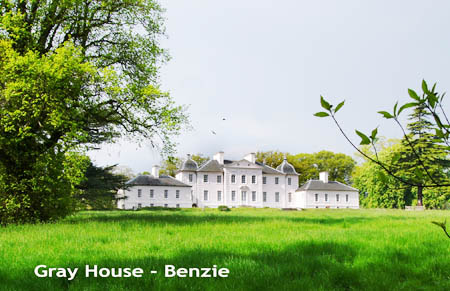
"Peter Gordon younger of Abergeldie, Eldest Lawful son to Charles Gordon of Abergeldy in ye parish of Crathy in the shire of Aberdeen & Mrs Elizabeth Gray, third lawful daughter to ye Right Honourable John Lord Gray in this parish were contracted."
Michael Francis Gordon and his family have tombstones in Cortachy Cemetery - a cemetery that abuts Burnside. His father, confusingly also John Gordon, was a Shepherd (let us call him, to avoid mix-up, 'John Gordon the Cortachy Shepherd') and was married to Jane Stewart. This John hailed from Upper Deeside. His son Michael Francis was indeed born at Birkhall there.
John Gordon the 'Cortachy Shepherd' died 6 months after John Gordon 'Incredible Son One'. They died on neighbouring holdings. One has to assume they were related - presumably as cousins. But still, one has to ask, what took our 'Incredible Son One' back to Cortachy to die??
So this is a coincidence of sorts - will you allow the writer to call it - Coincidence four?
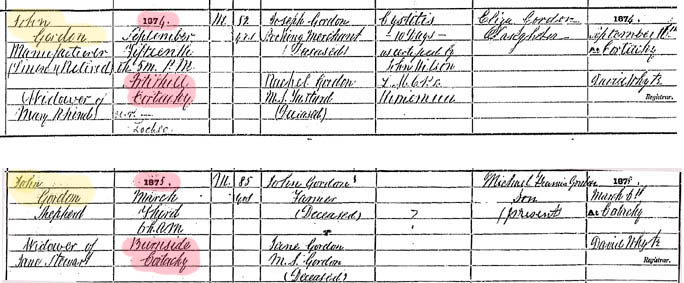
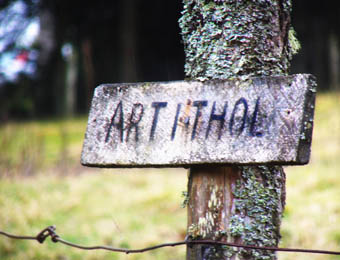
Joseph, like many of his sibs, made new horizons, over the mounth to the Glens of Angus. Here is what Dr Bulloch recorded of him (based on an account by 'Mrs Forbes'):
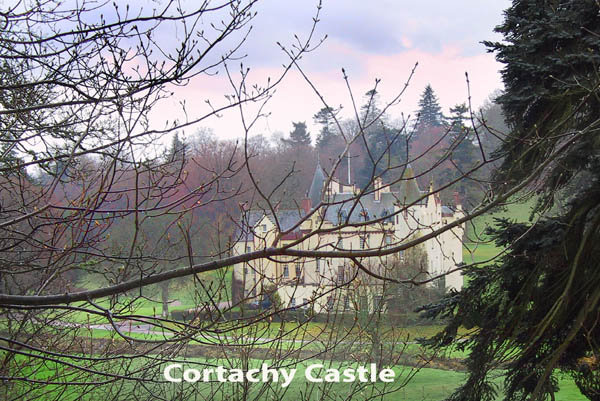
But as plausible, might a hypothesis be, that he was introduced by 'landed family' and to that end, where else would this writer turn to but to Abergeldie! So the following has NO solid footing, but nevertheless, represents a scenario that is worth following.
Whatever - again it is time to count overlapping-paths: thus might we have Coincidence five?
The first connection is between the Ogivies and Abergeldie: it goes back to the mother of Rachel Gordon the 10th Laird of Abergeldie. Rachel's mother was Euphemia Graham. This Euphemia seems to have lived to a grand-age, and was herself the daughter of John Graham of Morphie and Elizabeth Ogilvy of Inverquharity.
Now Inverquharity Castle neighbours Cortachy, and was helmed by the Ogilvy family. From the charts this writer has seen, he cannot (apart from very early connections) make clear links between this Elizabeth Ogilvy and the Earls of Airlie. Nevertheless they were neighbours.
Without checking the Airlie papers, it is only possible to say that Joseph Gordon was employed by one or two (or both) of the following Lairds:
1) Walter Ogilvy of Clova, '5th Earl of Airlie'
(born 1733, died April 1819)
First wife: Margaret Fullarton (died 1780)
Second wife :Jean Ogilvy (c1762-1818, dau of John Ogilvy of Murkle)
2) David Ogilvy, 6th Earl of Airlie (2nd son of above)
(born 1785, died Sept1849)
First wife: Clementina Drummond (married Oct 1812)
Second wife: Margaret Bruce (married 1838)
A little further scrutiny of the Ogilvys of Airlie brings us to a convincing connection between this family and the 'Hunters of Burnsyde' a.k.a.: Coincidence Six?
From the above, you may have noted that Walter Ogilvy was the Fifth Laird of Airlie. He had succeeded to his brother David, the 4th Laird in March 1803. Now this David Ogilvy is of considerable interest. Yes indeed.
David Ogilvy (1725-1803), was, you see, attainted during his father's lifetime for his support of the 1745 rebellion.
Let us go back to 1746, and I quote: "Hunter of Burnside escaped after Culloden with Lord Ogilvy in a party of twelve or thirteen persons. After hiding in Buchan, they 'got safe to Bergen' in Norway before moving on to Sweden and finally to France."
Thus, the point of true significance: David, Lord Ogilvy of Airlie was a companion of David HUNTER of Burnside, both of whom were suffering greatly after Culloden in 1746. So Airlie and Cortachy and Burnside were true bedfellows. Was this how Joseph Gordon ended up in service at Cortachy under Earl Airlie?? Recalling that TWO Burnside children married into Abergeldie: Alisone Hunter (1723- 1800) who married Charles Gordon 12th Laird of Abergeldie, and David Hunter (1721-1799) who married Barbara Gordon (sister of above Charles.) These families were knitted together - of that there can be no doubt.
The mother of the Hunter sibs (that married the Abergeldie Gordon sibs) was none other than another Graham - Amelia Graham. Again please make a mental note of that fact. The father of the Abergeldie Gordon sibs was Peter Gordon the 11th Laird, and the mother (author's opinion) was Elizabeth Gray.
Thus coincidence Six homes in, once again, to (no earlier) than that pivotal marriage of Peter Gordon 11th Laird to Elizabeth Gray. A marriage that brings us the Hunters of Burnsyde & Ogilvys of Airlie, and also to the Grahams (a generation before & after). All that is hard to follow - I know. The link to the following chart may help.
At present that is about as much as this writer can present on the Cortachy subject. It may be worth noting that Morphie Castle Estate (mentioned above in relation to Euphame Graham) was to be found just a few miles north of Montrose, in Lower Glen Esk. For later, that is worth noting. Again, it is worth re-stating, that the next recorded stopping point, after Cortachy, for Joseph Gordon the eponomously entitled 'Incredible Son 2' was Montrose.
At the National Archives in Edinburgh one can find the following:
Personal correspondence of Clementina, Countess of Airlie: Letter from Joseph Gordon to the Countess asking her acceptance of a volume of poetry he has just published 'as they were mostly composed when in your Ladyships service'. Kirriemuir, 25 August 1825.
A fascinating fragment survives, printed in the Sydney Morning Herald of November 1844, which serves to highlight Joseph, as a man of sturdy & robust disposition with true prowess over his language. This was a man of high education: read the following and you will understand:
HAWKERS AGAIN - Nov. 13 1844.
This day, JOSEPH GORDON appeared before the Bench on a summons charged with a breach of the Hawkers and Pedlars Act. G. Wright, Esq., appeared for the prosecution; the defendant conducted his own case. The defendant it appeared arrived at Bathurst early last week, and a few days after a quantity of goods that he had despatched before he left Sydney, arrived. From the time of his arrival at Bathurst until yesterday morning, he had become the inmate of an inn kept by Mr. P. White; on Saturday last, he engaged Mr. John Trewren, auctioneer, to sell those goods by auction for him, defendant receiving the cash for the lots as they were knocked down - a private sale was also proved. The defendant attempted to show having become a resident, but in this he failed as the occupancy of the premises he stated to have hired did not commence until two days after the offence he was charged with had been committed; he called but one witness, who instead of being useful to his case, made more against it than otherwise. the Police Magistrate intimated that the Bench considered a claims case could not be made out and he was convicted in a penalty of �10 (pounds) and 15s. costs. The defendant first gave notice of an appeal to the Quarter Sessions; but finding some difficulty in getting the necessary recognizances for proceeding the appeal entered into, has now intimated his intention to pay the fine.
The Police Magistrate intimated to the auctioneer, that a strong dislike was felt by the Bench to the practice of night auctions - and that if he continued holding them, he would do so at the risk of having the usual certificate necessary to a renewal of licence, refused when he applied for it; for that he, as one of the Bench, should object to the granting of it, were he to continue the practice.
Sydney Morning Herald. 18th November 1844.
====================================================================
To the Editors of the Sydney Morning Herald.
"Gentlemen -
Your Bathurst correspondent of November 13, in reporting the case tried at the Police Office there, on that day, headed "Hawkers again." says the defendant attempted to show having become a resident, but in this he failed, as the occupancy of the premises he was stated to have hired did not commence until two days after the offence he was charged with had been committed. Had he said the truth, I took the premises I now occupy, on Tuesday, the 5th November, at �1 (one pound) per week, the rent to commence from the following Monday; but in the mean time with perfect liberty to enter and possess whatever I might think proper to do so.
I am not aware in what respect my witness was more against my case than otherwise as stated by your correspondent; he proved that I had agreed verbally for the premises I now possess, fully forty-eight hours before my goods arrived from Sydney; and a verbal agreement between landlord and tenant. Mr. Gilbert Wright must admit, I presume, to be good in law for three years at least. That I had as good a right to sell my own goods in my own premises from the moment I entered, either by public auction or private sale, as any one in Bathurst, I believe, and will maintain, at whatever price - at whatever peril.
It was not for me to proclaim by sound of trumpet that I meant to become a resident, neither was it for others to take for granted that I had taken extensive premises and commenced a business with a different intention. But the truth is, Mr. Thomas Jones, Chief Constable and Informer, had a five pound reason for suspecting my motives, and for five pounds, that respectable class called informer, would, no doubt, suspect any one of anything.
As for Mr. Gilbert Wright, he is understood to be employed by the shopkeepers to prosecute all and sundry who would presume to pick a few berries from the same bush with themselves; and should he be obliged to do a little dirty work now and then, he has the consolation of knowing that he can wipe his fingers when he has done, with from twelve to fifteen pounds. That the Police Magistrate intimated that the Bench considered a clearer case could not be made out, may, or may not be true; I did not hear him make the remark, but your correspondent could not be deaf to the voice of public opinion in and around Bathrust, and he must acknowledge, if he has any regard for truth, that the voice was loud in condemnation of the whole proceedings.
A few more such convictions, and I feel firmly persuaded in my own mind from what I have heard and seen, that the confidence of many, very many, would be much shaken, if not entirely destroyed in the fair, impartial, and even-handed justice of the Bench of Bathurst. This may be thought to be the vindictive and acrimonious language of a defeated, and therefore prejudiced party; it is not so; it is maturely weighted and well considered and uttered in the calm, sober, serious, and full assurance of its solemn truth.
May I beg you will do me the favour to give insertion to the above in your widely circulated journal, and oblige, Gentlemen,
Your very obedient servant,
JOSEPH GORDON.
Bathurst, November 21st 1844
Sydney Morning Herald.....25.11.1844
-------------------------------------------------------------------------------------------------------------------
BATHURST REPORT......6 December 1844.
(Our reporter has sent us a lengthy justification of a police report which was attacked by a person named GORDON; but we do not think it necessary to insert it, as there was no reason to doubt its accuracy, notwithstanding Mr. Gordon's letter.)
Joseph named three Executors of his estate (George Busby, George Chisholm & William Dryman) all of whom were merchants in Bathurst, and as it turned out, all three of whom predeceased Joseph Gordon.
Joseph divided his estate between his sibs - but left the largest share to his older brother 'John Gordon of Rhye Hill, Lochhee, near Dundee, Manufacturer' which Joseph wished his brother to divide amongst his children.
Joseph also left �50 to his 'half-brother Donald Gordon, Broughty Ferry' and �50 to his 'half-sister Elizabeth Gordon or Michie.'
A couple of points are worth reflecting upon here: Was Joseph prompted to write his Last Will, after hearing the news of the recent death of his father? Also note that at the end of January 1851, 'half-brother Donald' was definitely in Broughty Ferry.
In 1874, Joseph said goodbye to his brother John. A final parting of two remarkable brothers. Then like a 'falling sledgehammer' just 4 years after John's death, the City of Glasgow Bank crashed. Now who had the financial resources to 'bail-out' the family of his deceased brother John. Well, one suspects it was Joseph (though 'half-brother Donald also appears to have been there to force capital).
All this is important, and indeed marvels the writer, that when in Spring 1888, Joseph Gordon in his 88th year passed away he was living not in 'reduced circumstances' but in fact the contrary. His last home was 15 Springfield, Dundee, described by David M. Walker in 'Architects and architecture in Dundee 1770-1914' as 'the finest of the few terrace developments in Dundee.'
Now for that name SPRINGFIELD - you will have to trust the writer here, but this surely has to be Coincidence seven.
At present, the writer does not Know the architect of Springfield other than understanding that he was an 'Edinburgh Architect.' This may seem unimportant & cryptic, but later, when it comes to telling the story of James Gordon 'Incredible Son 3' hopefully a pattern will emerge.
Joseph's Inventory, on his death, scheduled his Estate at a worth of nearly �2400. Had it not been for the City of Glasgow Bank crash three years earlier, one suspects it might have been a whole lot more!!
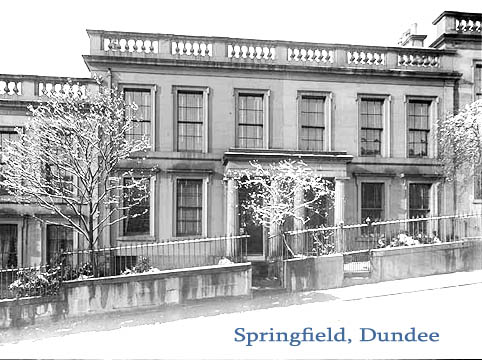
The exact dates, of James Gordon 'Incredible Son 3' are unknown but he was probably born circa 1796 at Bovagli', Glengirnoc.
James Gordon: He became a gardener, and for some years acted as such at Crawford Priory, Fife. Emigrating to Cape Colony, he became a farmer in the first raid of the Boers into British territory, he and his wife were attacked and massacred, only one, a young boy, escaping by hiding himself. I do not know what became of this survivor.
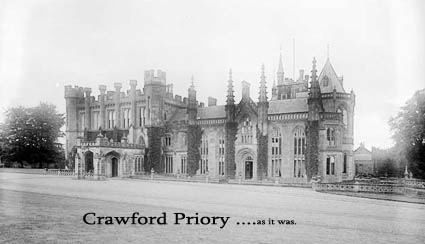
So the most glaring question: What took a 'Girnoc loon' all the way to Crawford Priory in Fife? Well that as yet cannot be addressed completely, yet their are some intriguing possibilities: time then for Coincidence Nine.
At this point, the writer wishes to state that the clever historical research, upon which most of the above account has so far been based, could not be attributed to this writer's own cerebral capacity (for there are great echoes, within his cranial vault, he assures!) So please, instead, toast a dear Australian Gordon (she knows who she is) - the credit should go to her.
"Crawford Priory is a remarkable ruined country house, lying immediately to the south of Springfield (Fife) and 3 miles (5 km) southwest of Cupar. Originally built as an unassuming villa by the Earl of Crawford in 1758, Crawford Priory was rebuilt from 1809 for Lady Mary Lindsay Crawford. The rebuilding was begun by architect David Hamilton (1768 - 1843) but in 1811, James Gillespie Graham (1776 - 1855) was retained to complete the work. Hamilton hid the earlier house in High Gothic, while Graham extended it to the rear in Ecclesiastical Gothic, giving it the style of a Priory. When the house passed to the 4th Earl of Glasgow in 1833, he made minor alterations and further restyling was completed by the 6th Earl in 1871. Reginald Fairlie moved the porch in 1920. This house has been described as 'perhaps the most important Gothic Priory house in Scotland.'
As changing financial circumstances meant that maintaining a country house became exorbitantly expensive, so parts of Crawford Priory were closed off. Eventually the entire house was abandoned and it has lain derelict since 1971, slowly falling apart."
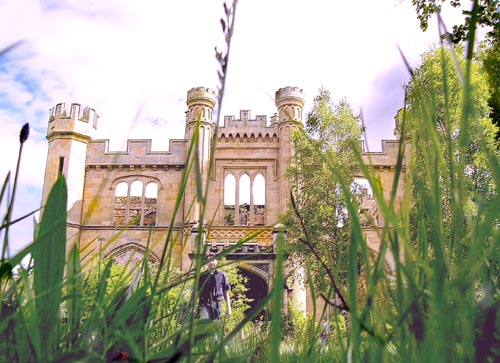
This was some place. That cannot be disputed. Love or loathe this style of 'Gothic revival' architecture - that does not matter, for as a place Crawford Priory oozes that indescribable something. It is a spectacular ruin.
A brief overview of the Lindsay-Crawford family has been made, but no obvious connection appears between that family and some of the family groups so far discussed. This tends to focus the writer upon the Graham connection. A further coincidence here: Now where does Crawford Priory sit? - well it is in the parish of Cults, Fife. And what is it's nearest settlement? - well it is Springfield!
Remember the Dundee terraces of 'high architecture' - in No 15 Springfield, lived Joseph, brother of 'Crawford gardener' James Gordon. Could it be that the 'Edinburgh architect' for Springfield, Dundee was none other than James Gillespie Graham??
Poor James and wife to have been lost in the first raid of the Boers into 'British Territory' - as Dr Bulloch said, one has to wonder what fate the young boy who 'hid himself' had.
Donald Gordon was born on Bovagli Farm in 1812. He was a coal, grass and fodder merchant at Dundee, and, like his brother Joseph, suffered through the City of Glasgow Bank failure. He married December,1846, at Meathie, near Forfar, Margaret Anderson, and had four children. It was his daughter Margaret, 'Mrs Forbes' that in 1913, was the informant for Dr Bulloch.
Now, very briefly, let us talk of Margaret Gordon later 'Mrs Forbes.' Well she was born in Broughty Ferry in late January 1850 - likely her first breath was shared by the dying breath of her old grandfather 'Camlet Joseph' who spent his last days with the family. Margaret Gordon married John Forbes, who was Headmaster at Springfield. Coincidence Ten, thus sneaks its way in. At Springfield, Fife they stayed until they moved on retiral to Milnathort Fife. A great-grandson of 'Camlet John' went also to Milnathort around this time.
Dr Bulloch stated at this point "Mrs. Forbes gave me a lot of information about the family in 1913 which I published in the Aberdeen Weekly Journal, 5th September 1913." This newspaper survives and the writer promises to read and transcribe it. You never know what extra it might bring?
One final small point whilst discussing Donald Gordon's family: he had just one son William Gordon, who was lost in the sinking of the Kowshing by the Japanese at the outbreak of the Chino-Japanese War (25th July 1894.) William Gordon married a Forbes also, in fact the sister of the Headmaster Forbes of Springfield. One has to wonder then about this Forbes family of Springfield?
John Gordon, his wife Ann Selbie, and family, made that move sometime after 1852 but before 1858, when their last son Robert Walker Gordon was born at Collairniehill.
Collairniehill was a shepherding croft on the Collairnie farm, lying (the writer estimates) 10 miles north of Springfield. Any connection here is again utterly speculative - but entirely plausible.
A recent discovery, has revealed that there was another Deeside Gordon at Collairniehill, just before John Gordon (1816-1899) & family moved there. Perhaps then the form of introduction & perhaps displacing the above speculation.
The 1851 Gordon family at Collairniehill was listed thus:
1851 Census - Collairnie Farm, Dunbog parish, Fife
John Gordon, Head, Married, age 46yrs, Shepherd, born Braemar (One can only assume that this 'Braemar John' knew 'our John' - were they related? - did 'Braemar John' introduce 'our John' to Fife & Collairniehill??)
Margaret Robertson, Wife, age 31yrs, born Moulin, Perthshire
Margaret Gordon, Daughter, age 13yrs, born Blairgowrie
Isabell Gordon, Daughter, age 6yrs, born Blairgowrie
James Gordon, Son, age 4yrs, born Dunbog
John Gordon, son, age 12mths, born Dunbog
Tracing this family surely would be interesting. Brief work so far, has not placed this 'other,' slightly-older 'Braemar' Gordon. Gut-feeling of the writer, is that this John & family emigrated.
This writer has no interest in lists. Names mean nothing but stories mean everything. That is why, the writer guesses, he has enjoyed this account like no other. The multiple coincidences may indeed come to nothing - but in cumulo they do strike loud. Without primary source they should however always remain as 'thoughts' - the writer could think of nothing worse than re-inventing the history of his glen-folk.
1) It is this writer's belief that there was NO Gordon family at Camlet prior to 1750. Before that date OPR records have other families there - notably at least one family of the name 'GRAY' (could they be sibs of Elizabeth Gray, the second wife of Peter Gordon the 11th laird??)
2) Primary Records continue to ellude, but, this writer has not found anything to dispute 'Crovie John's' statement that the mother of 'Camlet John' was a LEYS. The Endowment of 1872 state that the mother was 'Barbara Lay.'
3) This writer speculates that 'Camlet John' and 'Camlet Joseph' were brothers, but that Joseph was the older of the two, and thus gained greater 'family support.' This would fit with what the writer's Great-Aunt Mabel said (in her infamous folk-lore.) Yes he was as confirmed by the Endowment of 1872 by 'Mormon John.'
4) Connections with 'Camlet Francis' make him to be equally as likely a brother, of John & Joseph. The writer would 'guesstimate' (from the years of marriage) that Francis Gordon might have been the youngest brother. The links between Camlet & Birse are indisputable and cover the bairns of both 'Camlet John' and 'Camlet Francis.' There also appears to be strong links with Aberdeen family. Yes he was as confirmed by the Endowment of 1872 by 'Mormon John.'
5) So if these three 'loons' were brothers, who were their parents, and where did they come from before Camlet? Well there is one artefact that suggests they possibly came from Abergeldie Mains: As per the quote of David Burnett Gordon in 1905: "My grandfather's name was Francis Gordon. He was farmer of the home farm of Abergeldie , for three nineteen years, previous to 1834, the year I was born." That would give a date of move to Camlet circa 1767. The 11th Laird who died in Sept 1733 (in his early 40's) had a large Inventory (but no Will) - the Inventory confirms the Mains of Abergeldie as the 11th Laird's true love - he seems to have invested everything into rejuvinating his farm enterprise. Was 'Peter Gordon in Balindory' a natural son of the 11th Laird?
6) So therefore, could the 11th Laird, Peter Gordon of Abergeldie, have sired an unknown (and perhaps illegitimate, as according to Aunt Mabel) son that married a lass named Leys. This couple then had at least three sons: Joseph, John & Francis.That would certainly fit with much of the above account and the coincidences therein. . Follow this link to 'Peter Gordon of Balindory.'
It is time to present a counter-balance to the superlative sons of Joseph.
The first son by Joseph's second wife, Margaret Stewart, was born in 1801 at Bovagli' and named Alexander. He was known as Alex.
This Alex was a notorious smuggler. He was caught many times and imprisoned. He even managed to escape from Perth Prison! In 1830 he was charged with an assault as follows:
Charge against Alexander Gordon, Labourer in Burnside in the united parishes of Glenmuick, Glengarden and Tullich in the County of Aberdeen.
That upon the thirteenth day of February eighteen hundred and thirty, or on one or other of the days of that month, or of January immediately preceding, or of March immediately following, the said Alexander Gordon did, at or near to, the dwelling house at Bridge Foot or Burnfoot of Braickley, in the said United Parishes & County, then and now or lately occupied by John Stewart, then and now or lately Labourer, wickedly and feloniously attack and assault Donald Coutts, now or lately Farmer or Crofter at Ballintobar, in the said united parishes and County, and did, then and there, strike the said Donald Coutts a severe blow on the head, with a fist or a stick, or some other hard substance, and did thereby knock the said Donald Coutts to the ground, and while he was lying on the ground, the said Alexander Gordon did again strike the said Donald Coutts several severe blows on the head and other parts of his person � with his fists or with a stick, or some other hard substance: by all which the said Donald Coutts nose were fractured and he was otherwise much bruised, and wounded on the head, and to the great effusion of his blood, and was, in consequence, confined to Bed for several days thereafter.
Follow this link to a poem on the Smugglers
